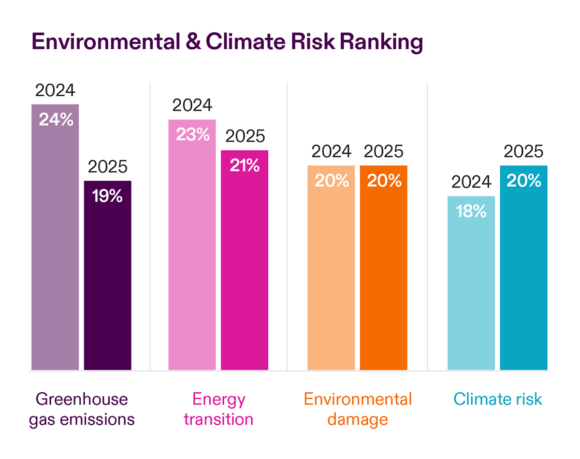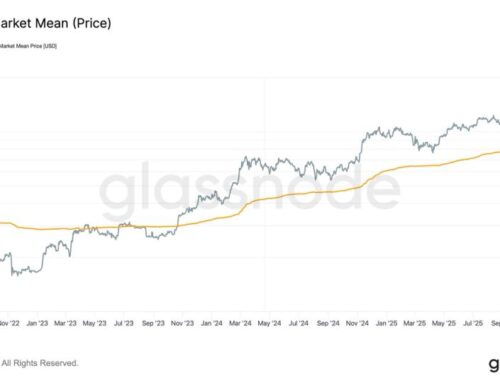Study: Economic Uncertainty Diverting Executive Attention From Sustainability
March 28, 2025
It’s the economy stupid, and it seems that a lot of executives are using their brain power on their current worries rather than on the climate concerns of tomorrow—despite those concerns materializing in the here and now.
Executives are focused on meeting current economic challenges, putting intensifying environmental and climate risk concerns on the backburner, according to a study from Beazley.
The insurer’s Spotlight on Environmental & Climate Risk 2025 report includes observations from 3,500 global business leaders on how they perceive climate risk, the energy transition, greenhouse gas emissions and environmental damage to their operations.
The report shows that nearly two-thirds (73%) of them believe the current economic climate makes meeting their sustainability targets less of a priority, and 67% are finding it hard to transition to non-carbon energy and meet net zero targets.

Roughly one-third (34%) plan to increase energy efficiency this year, up from 23% in 2024, but only 19% see greenhouse gas emission risk as a significant concern (down from 24% in 2024).
“In the current economic environment executives are focusing on the here and now, risking missing the elephant in the room,” the report states. “The past year has seen California ablaze, deadly floods in Spain, and unprecedented storms, making extreme weather the new norm. These events cause devastation, and increase the risk of environmental damage, commodity shortages, supply chain and business interruption, yet just 20% (up from 18% in 2024) of global executives that we surveyed rank climate risk and associated catastrophic risk as a top concern.”
Renewables
There’s big opportunity in servicing—and insuring—renewables, if you were listen to what UN Secretary-General António Guterres is saying.
Guterres was addressing the 16th Petersberg Climate Dialogue in Berlin, during which he issued a strong call for decisive climate action.
He also called out some impressive stats about renewables and renewable growth:
- 2024 was a record year for global renewable energy production, according to the International Renewable Energy Agency.
- Renewables made up 92% of new electricity capacity installed last year.
- Europe’s capacity rose by 9%, with Africa’s capacity grew by 7%.
- Wind power cost has dropped 60% since 2010, and solar is 90% cheaper.
- Clean energy accounted for 5% of India’s GDP growth, 6% of the U.S. GDP and roughly one-third of the EU’s.
“All of this is another reminder of a 21st century truth: Renewables are renewing economies,” Mr. Guterres said. They are “powering growth, creating jobs, lowering energy bills, and cleaning our air.”
Extreme Weather
Climate change is causing more extreme weather around the globe, increasing the odds of severe drought and heavier precipitation.
California is an example of both: The state was facing another severe drought until 2023, when record-setting rain and snowfall led to heavy vegetation growth that helped fuel January’s destructive wildfires in Los Angeles.
How can global warming cause both drier and wetter extremes? The Associated Press in an article on Insurance Journal posed that question to experts.
The AP report explains that water constantly moves between the planet and the atmosphere. But that hydrological cycle is speeding up as global temperatures warm and a hotter atmosphere sucks up more water vapor from bodies of water and vegetation and soil.
On the land, this atmospheric demand and loss of surface moisture leads to longer and more intense droughts. Rain falls less often, but when it does, it’s often in intense and destructive deluges. That’s because the atmosphere holds 7% more water vapor for every degree Celsius, according to the report.
“Basically, global warming is turning the atmosphere into a bigger sponge so it can soak up more moisture … and then when the conditions are right for rainfall, it’s like squeezing that sponge,” Jonathan Overpeck, a climate scientist at the University of Michigan, told the AP. “You get more moisture coming out faster.”
Climate Activists
Are climate activists having an impact?
Behavioral scientists at Yale reviewed dozens research articles looking for evidence that climate activism influences public opinion and media coverage.
They found that it can, depending on the tactics used by activists and the way the media covers the events.
“There is strong evidence that climate activism shifts public opinion and media coverage in a pro-climate direction, but this varies by context and the tactics employed,” the article published in ScienceDirect states. “There is more moderate evidence that activism can pressure policymakers to communicate more about climate change, encourage voters to vote in a more pro-climate direction, and financially pressure carbon-intensive companies.”
The study found that protests usually increase support for a movement when they are peaceful, but not when they are violent. Researchers also found evidence that the influence of activism on public perceptions can be either positive or negative depending on the tone of the media coverage of the protests.
Past columns:
Was this article valuable?
Thank you! Please tell us what we can do to improve this article.
Thank you! % of people found this article valuable. Please tell us what you liked about it.
Here are more articles you may enjoy.
Search
RECENT PRESS RELEASES
Related Post




